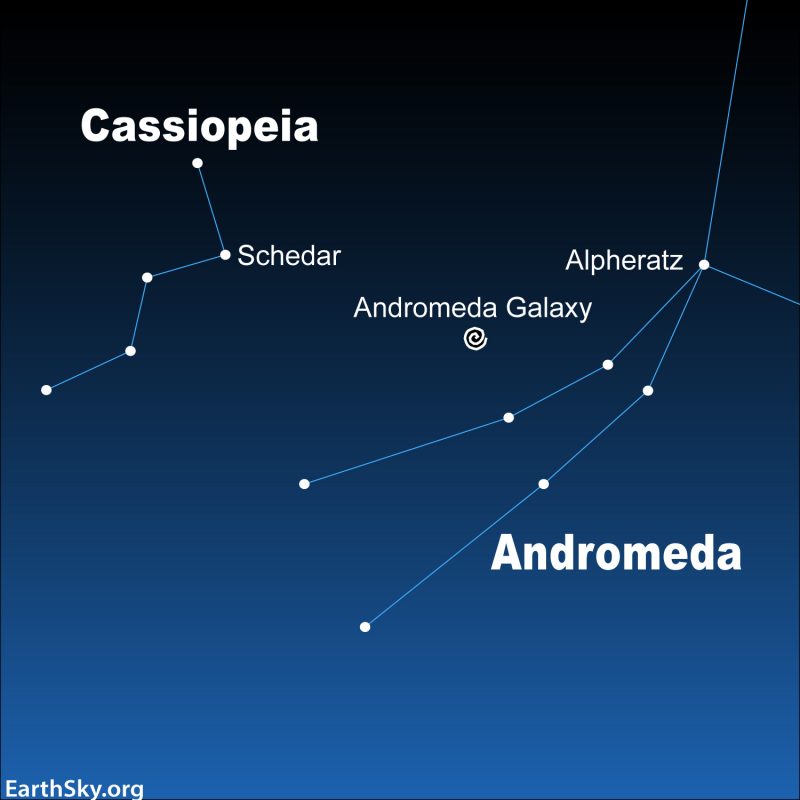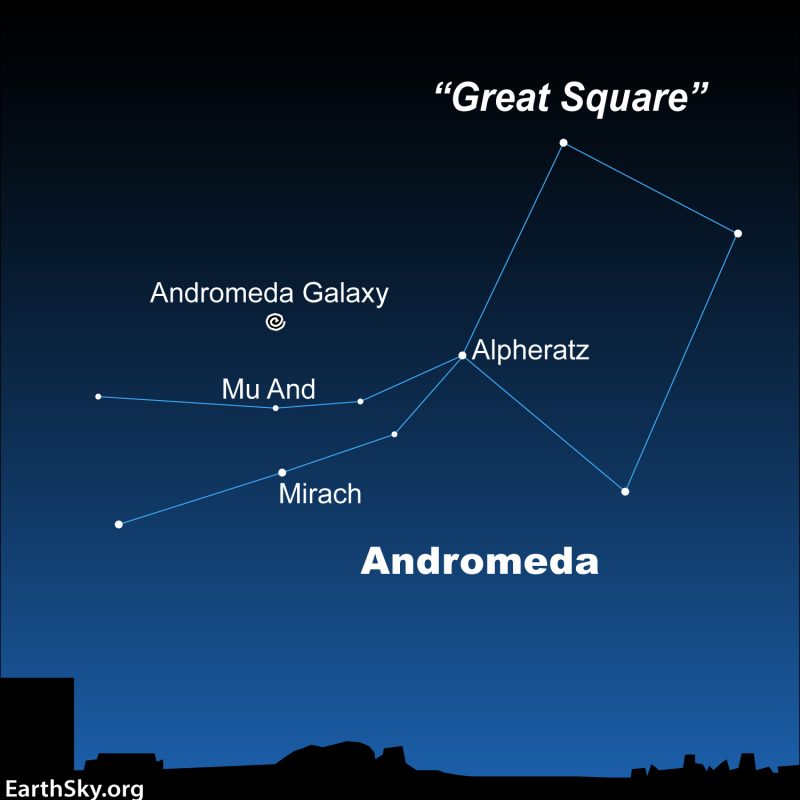
2 ways to find the Andromeda galaxy
Take a night to drive to a dark sky and find the glorious Andromeda galaxy. It’s the great spiral galaxy next door to our Milky Way and the most distant object you can see with your eye alone. It’s best seen in the evening at this time of year. Most people find the galaxy by star-hopping from the constellation Cassiopeia the Queen. It’s a very noticeable M- or W-shaped pattern on the sky’s dome. You can also find the Andromeda galaxy by star-hopping from the star Alpheratz in the Great Square of Pegasus. Both methods will lead you to the galaxy. See the charts below.
Star-hop from Cassiopeia

Star-hop from the Great Square of Pegasus

The importance of a dark sky
Just be aware – bright moonlight or city lights can overwhelm the faint glow of this object. The single most important thing you need to see the galaxy is a dark sky.
What does the galaxy look like to the eye? Assuming you have a dark sky, it appears as a large fuzzy patch – bigger than a full moon in the sky – but vastly fainter and more subtle.
Binoculars enhance the view
Binoculars are an excellent choice for beginners to observe the Andromeda galaxy, because they are so easy to point. As you stand beneath a dark sky, locate the galaxy with your eye first. Then slowly bring the binoculars up to your eyes so that the galaxy comes into binocular view. If that doesn’t work for you, try sweeping the area with your binoculars. Go slowly, and be sure your eyes are dark-adapted. The galaxy will appear as a fuzzy patch to the eye. It’ll appear brighter in binoculars. Can you see that its central region is more concentrated?
With the eye, or with binoculars, or with a backyard telescope, the Andromeda galaxy won’t look like the image below. But it will be beautiful. It’ll take your breath away.

Bottom line: The neighboring Andromeda galaxy – nearest large spiral galaxy to our Milky Way – will be visible on dark, moonless evenings from now until the beginning of northern spring. Here are two ways to find it.
Read more about the Andromeda galaxy: All you need to know
The post Here are 2 ways to find the Andromeda galaxy first appeared on EarthSky.
from EarthSky https://ift.tt/3BoQoVR

2 ways to find the Andromeda galaxy
Take a night to drive to a dark sky and find the glorious Andromeda galaxy. It’s the great spiral galaxy next door to our Milky Way and the most distant object you can see with your eye alone. It’s best seen in the evening at this time of year. Most people find the galaxy by star-hopping from the constellation Cassiopeia the Queen. It’s a very noticeable M- or W-shaped pattern on the sky’s dome. You can also find the Andromeda galaxy by star-hopping from the star Alpheratz in the Great Square of Pegasus. Both methods will lead you to the galaxy. See the charts below.
Star-hop from Cassiopeia

Star-hop from the Great Square of Pegasus

The importance of a dark sky
Just be aware – bright moonlight or city lights can overwhelm the faint glow of this object. The single most important thing you need to see the galaxy is a dark sky.
What does the galaxy look like to the eye? Assuming you have a dark sky, it appears as a large fuzzy patch – bigger than a full moon in the sky – but vastly fainter and more subtle.
Binoculars enhance the view
Binoculars are an excellent choice for beginners to observe the Andromeda galaxy, because they are so easy to point. As you stand beneath a dark sky, locate the galaxy with your eye first. Then slowly bring the binoculars up to your eyes so that the galaxy comes into binocular view. If that doesn’t work for you, try sweeping the area with your binoculars. Go slowly, and be sure your eyes are dark-adapted. The galaxy will appear as a fuzzy patch to the eye. It’ll appear brighter in binoculars. Can you see that its central region is more concentrated?
With the eye, or with binoculars, or with a backyard telescope, the Andromeda galaxy won’t look like the image below. But it will be beautiful. It’ll take your breath away.

Bottom line: The neighboring Andromeda galaxy – nearest large spiral galaxy to our Milky Way – will be visible on dark, moonless evenings from now until the beginning of northern spring. Here are two ways to find it.
Read more about the Andromeda galaxy: All you need to know
The post Here are 2 ways to find the Andromeda galaxy first appeared on EarthSky.
from EarthSky https://ift.tt/3BoQoVR

Aucun commentaire:
Enregistrer un commentaire